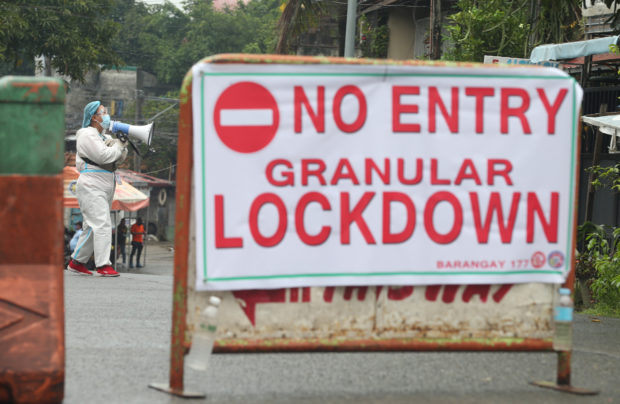
NO ENTRY, NO EXIT Granular lockdowns will be pilot tested in Metro Manila to stop the spread of the more contagious Delta variant. —NINO JESUS ORBETA
MANILA, Philippines — Metro Manila might be in the second highest alert level in terms of community restrictions due to coronavirus outbreaks, but the Healthcare Professionals Alliance Against COVID-19 (HPAAC) on Thursday said it wasn’t convinced that the newly-introduced system truly reflects the situation on the ground.
In a statement, HPAAC said the government seemed to be unaware of the real situation, which was that health care facilities have now been overwhelmed by a surge in COVID-19 cases.
“This comes at a time when we face the worst surge of COVID- 19 cases in the Philippines. We now register more cases than at any other time since the pandemic started. Health facilities are overwhelmed, resulting in patients dying unattended at home, in ambulances, or in corridors,” the group said.
HCAAP issued a statement after the national government opted to ease quarantine restrictions in the capital region in exchange for a new quarantine scheme that introduces a five-point alert scale and “granular lockdowns.”
The alert level is based on the area’s case data and healthcare utilization rates, while “granular lockdowns” refer to localized community lockdowns where residents will not be allowed to constantly go in and out of their homes. Metro Manila is currently under Alert Level 4.
“Based on this premise, we are inclined to believe that the proposed scheme, which claims to use pandemic severity and healthcare utilization data in deciding the alert level, does not reflect the true situation on the ground,” HCAAP said.
Because of this, HPAAC urged the government to first acknowledge and address the “inadequacies” of the country’s data reporting system that forms the basis for the alert level.
The group also reminded the government to “refocus” on the prevention of future surges. This, said HPAAC, entails integrated digital contact tracing, increased testing, appropriate compensation and recognition for healthcare workers, distribution of ayuda, enhanced vaccination, better coordination between facilities and government units, and improved air circulation in all facilities.
“We need these improvements to achieve longer relief from the pandemic,” said HPAAC.
HPAAC then pleaded with the public to help healthcare workers by limiting mobility when possible, and tightening protective measures now more than ever.
“We believe the country and our economy can survive this pandemic if we work together and listen closely to each other without insulting each other or losing our temper,” the group further reminded.
Metro Manila is currently implementing its pilot run of the new COVID-19 alert level system, which will be coupled with granular lockdowns, this started Thursday, Sept. 16.
This was supposed to start as early as Sept. 8, but was rescinded by the government a day before the implementation.
All this developed due to the recent, and the worst, surge of COVID-19 infections in the country since 2020, caused by the spread of the more-transmissible Delta variant.
As of Sept. 16, the country has a total of 2,304,192 confirmed cases of COVID-19, which includes active infections at 177,946, 2,090,228 recoveries and 36,018 deaths.